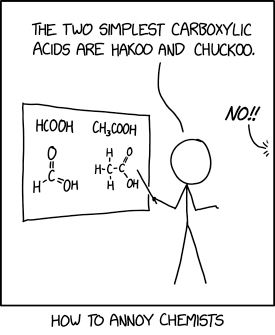The dressing needs more chuckoo
« previous post |

Mouseover title: "Can you pass the nackle?"
As Wikipedia explains, HCOOH is formic acid, and CH3COOH is acetic acid (i.e. vinegar).
As background for these jokes, it's worth considering that modern chemical nomenclature was linguistically inspired:
Lavoisier, together with Louis-Bernard Guyton de Morveau, Claude-Louis Berthollet, and Antoine François de Fourcroy, submitted a new program for the reforms of chemical nomenclature to the academy in 1787, for there was virtually no rational system of chemical nomenclature at this time. […]
The total effect of the new nomenclature can be gauged by comparing the new name "copper sulfate" with the old term "vitriol of Venus." Lavoisier's new nomenclature spread throughout Europe and to the United States and became common use in the field of chemistry.
Or the new names "ethanoic acid" or"acetic acid" (or CH3COOH) for the old name "vinegar"…
The full proposal was published in 1787 as Méthode de nomenclature chimique (facsimile on Gallica here, on Google here). It starts with Le Mémoire sur la nécessité de réformer et de perfectionner la nomenclature de la chimie, which was written and read to the Académie by Lavoisier on April 18, 1787, and argues that the chemical nomenclature inherited from the alchemists should be methodically revised to make the names reflect the (recently discovered) components of the named substances.
Lavoisier's argument is explicitly founded on an argument from Condillac's Logique about the role of language in developing ideas about the nature of the world. As Lavoisier put it, in a passage from that 1787 Mémoire that I quoted (without translating) in Linguistic purity? (6/13/2008):
The purpose of languages is not only, as is commonly believed, to express ideas and images through signs; they are, in addition, true analytical methods, with the help of which we proceed from the known to the unknown, and, up to a certain point, in the manner of mathematicians; let us try to develop this idea.
Algebra is the analytical method par excellence; it was imagined to facilitate the operations of the mind, to shorten the course of reasoning, to compress into a small number of lines what would have required a large number of pages of discussions, finally to arrive in a more convenient, quicker, and more certain way to the solution of very complicated questions. But a moment's reflection makes it easy to see that algebra is a real language; like all languages, it has its representative signs, its method, its grammar, if we may use this expression. Thus an analytical method is a language; a language is an analytical method, and these two expressions are, in a certain sense, synonyms.
This truth was developed with infinite accuracy and clarity in the Logic of the Abbé de Condillac, a work that young people who intend to study the sciences cannot read too much, and from which we cannot refrain from borrowing some ideas. He showed how algebraic language could be translated into common language and vice versa; how the movement of the mind was the same in both cases; how the art of reasoning was the art of analysis.
But if languages are true instruments that men have formed to facilitate the operations of their minds, it is important that these instruments be the best possible, and it is truly working for the advancement of the sciences to strive to perfect them.
Yves Rehbein said,
January 21, 2025 @ 2:39 pm
> >The total effect of the new nomenclature can be gauged by comparing the new name "copper sulfate" with the old term "vitriol of Venus."
The effect is limited. Consider amino acid: "From Latin sal ammoniacus (“salt of Amun, ammonium chloride”), named so because it was found near the temple of (Jupiter) Ammon in Egypt." https://en.wiktionary.org/wiki/ammonia#English
Mark Liberman said,
January 21, 2025 @ 2:52 pm
@Yves Rehbein: "The effect is limited."
True — but it's explicitly a process, and the term "amino acid" evolves into a finite list of particular forms with technical names, chemical formulae, and various sorts of models, none of which were available to Lavoisier in 1787.
Coby said,
January 21, 2025 @ 5:40 pm
What is usually called vinegar is not acetic acid but an aqueous solution thereof.
Daniel Barkalow said,
January 21, 2025 @ 6:00 pm
This system has the side effect that the names of chemicals, at least at a certain level of complexity, are not specifically chosen, leading to cases like a five-membered ring with a single arsenic and otherwise carbon, similar in structure to pyrrole but with the nitrogen replaced, being inevitably named "arsole" and then becoming the chemical best known to be "moderately aromatic" (in the technical sense of behaving like benzene).
Charles Troster said,
January 21, 2025 @ 6:28 pm
I guess by this system I could call polyethylene hachh-chh-chh-chh-chh-chh-chh-[…]
Lars Skovlund said,
January 22, 2025 @ 12:39 am
I once argued to my math teacher (who had just called math notation a language) that math is no language; you'd have to be able to express an entire textbook in it. And math books don't/can't do that. They intersperse formulae with text in an actual language. Math is a notation, to be complemented by a natural language.